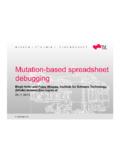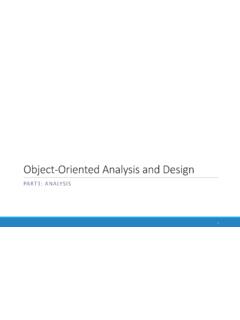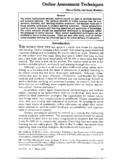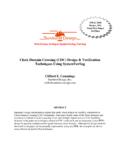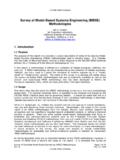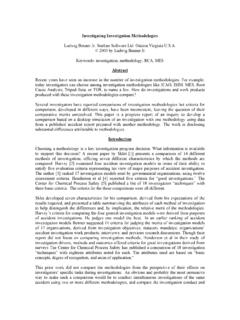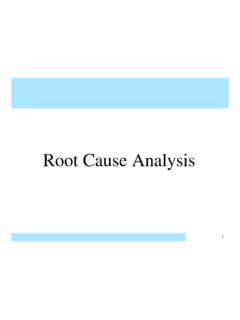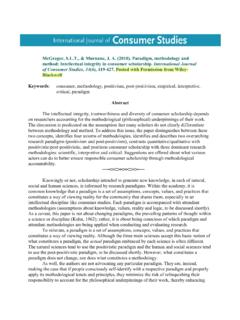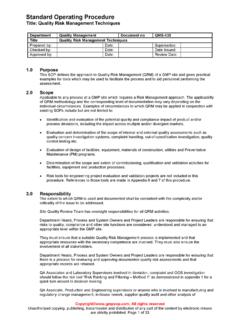Transcription of Design for Reliability: Overview of the Process and ...
1 International Journal of Performability Engineering Vol. 6, No. 6, November 2010, pp. 577-586. RAMS Consultants Printed in India _____ *Corresponding author s email: 577 Design for reliability : Overview of the Process and Applicable Techniques ADAMANTIOS METTAS Vice President, ReliaSoft Corporation, 1450 S. Eastside Loop, Tucson, AZ 85710, (Received on Aug. 17, 2009, revised December 11, 2009) Abstract: Design for reliability (DFR) is not a new concept, but it has begun to receive a great deal of attention in recent years. What is DFR? What are the ingredients for designing for reliability , and what is involved in implementing DFR?
2 Should DFR be part of a Design for Six Sigma (DFSS) program, and is DFR the same as DFSS? In this paper, we will try to answer these questions and, at the same time, we will propose a general DFR Process that can be adopted and deployed with a few modifications across different industries in a way that will fit well into the overall Product Development Process . Keywords: Design for reliability (DFR), reliability management, reliability planning. 1. Introduction All reliability professionals are familiar with the terms Weibull Analysis and/or Life Data Analysis. In fact, for many, these analysis techniques have become almost synonymous with reliability .
3 The reality, though, is that although life data analysis is an important piece of the pie, performing just this type of analysis is not enough to achieve reliable products. Rather, there are a variety of activities involved in an effective reliability program and in arriving at reliable products. Achieving the organization s reliability goals requires strategic vision, proper planning, sufficient organizational resource allocation and the integration and institutionalization of reliability practices into development projects. Design for reliability , however, is more specific than these general ideas. It is actually a Process . Specifically, DFR describes the entire set of tools that support product and Process Design (typically from early in the concept stage all the way through to product obsolescence) to ensure that customer expectations for reliability are fully met throughout the life of the product with low overall life-cycle costs.
4 In other words, DFR is a systematic, streamlined, concurrent engineering program in which reliability engineering is weaved into the total development cycle. It relies on an array of reliability engineering tools along with a proper understanding of when and how and to use these tools throughout the Design cycle. This Process encompasses a variety of tools and practices and describes the overall order of deployment that an organization needs to follow in order to Design reliability into its products. 2. Why is DFR Important? Why should a company commit resources for deploying a DFR Process ? The answer to this question is quite warranty costs and customer satisfaction.
5 Field failures are very costly. Adamantios Mettas 578 One case in point is the recently publicized Xbox? issue, which has cost Microsoft more than a billion dollars in warranties (aside from loss of business and market share). Clearly, in order to be profitable, an organization s products must be reliable, and reliable products require a formal reliability Process . Three important statements summarize the best practice reliability philosophy of successful companies: 1) reliability must be designed into products and processes using the best available science-based methods.
6 2) Knowing how to calculate reliability is important, but knowing how to achieve reliability is equally, if not more, important. 3) reliability practices must begin early in the Design Process and must be well integrated into the overall product development cycle. Understanding when, what and where to use the wide variety of reliability engineering tools available will help to achieve the reliability mission of an organization. And this is becoming more and more important with the increasing complexity of systems as well as the complexity of the methods available for determining their reliability . System interactions, interfaces, complex usage and stress profiles need to be addressed and accounted for.
7 With such increasing complexity in all aspects of product development, it becomes a necessity to have a well defined Process for incorporating reliability activities into the Design cycle. Without such a Process , trying to implement all of the different reliability activities involved in product development can become a chaotic situation, where different reliability tools are deployed too late, randomly, or not at all, resulting in the waste of time and resources as well as the occurrence of problems in the field. Managers and engineers have come to this realization and a push for a more structured Process has been seen in recent years.
8 The circumstances are very similar to what happened with the "Quality Assurance" discipline back in the 1980s, which spawned successful processes such as Six Sigma and Design for Six Sigma (DFSS). It is thus only natural for organizations to look to these existing processes and sometimes even try to include reliability into them. However, although Six Sigma and DFSS have been quite successful in achieving higher quality, reducing variation and cutting down the number of non-conforming products, the methodologies are primarily focused on product quality and many organizations are starting to realize that they do not adequately support the achievement of high reliability .
9 Therefore, these organizations are starting to put more emphasis on the separate, although often complementary, techniques of Design for reliability . Since the distinctions between reliability and quality, and consequently between DFR and DFSS, are often still poorly understood, it is worthwhile to address this topic briefly in the next few sections before presenting the overall Process and the specific techniques that comprise DFR. Distinction Between reliability and Quality H2 Grey Relation Analysis First, let us start with some basic clarifications. Traditional quality control assures that the product will work after assembly and as designed. Whereas reliability provides the probability that an item will perform its intended function for a designated period of time without failure under specified conditions.
10 In other words, reliability looks at how long the product will work as designed, which is a very different objective than that of traditional quality control. Therefore, different tools and models apply to reliability that do not necessarily apply to quality and vice versa. This is exemplified by the following comparison of DFSS (focused on quality) and DFR (focused on reliability ). Design for reliability : Overview of the Process and Applicable Techniques 579 Distinction Between DFSS and DFR Design for Six Sigma emerged from the Six Sigma and the Define-Measure-Analyze-Improve-Control (DMAIC) quality methodologies, which were originally developed by Motorola to systematically improve processes by eliminating defects.
